Ever wonder what makes a farmhouse kitchen feel so warm, inviting, and effortlessly charming? The secret often lies in the backsplash—a small detail with a big impact. Farmhouse kitchen backsplashes have surged in popularity because they beautifully blend rustic appeal with timeless elegance, adding character and personality to the heart of your home. Whether it’s classic subway tiles, reclaimed wood, or vintage tin, these designs create a cozy yet stylish backdrop that complements the entire space.
In this article, you’ll find a treasure trove of inspiration and practical ideas to elevate your farmhouse kitchen. From bold patterned ceramics to textured brick and charming handcrafted tiles, there’s a perfect backsplash for every style and taste. Get ready to explore a variety of ideas that will spark your creativity and help you craft a kitchen that’s uniquely yours—full of warmth, charm, and farmhouse flair!
1. Classic White Subway Tile for Timeless Charm

A white subway tile backsplash is the quintessential choice for achieving a classic, timeless farmhouse aesthetic that never goes out of style. Its clean lines and simple elegance make it a versatile foundation that complements a variety of kitchen styles and color schemes.
Imagine glossy, rectangular white tiles arranged in a traditional brick pattern, creating a seamless, orderly look. The crisp white surface reflects light beautifully, making your kitchen feel brighter and more spacious. The subtle grout lines add texture without overwhelming the space, while the smooth surface offers an easy-to-clean feature that balances practicality with style. This setup evokes a cozy yet fresh vibe, perfect for a farmhouse kitchen that values both charm and functionality.
Getting this look is straightforward: start with high-quality ceramic or porcelain subway tiles, measuring about 3×6 inches. Use a white or light gray grout for a subtle, cohesive appearance. Apply the tiles with a standard tile adhesive, ensuring even spacing. For an authentic touch, opt for a classic herringbone pattern or a slightly beveled edge for added dimension. This timeless backsplash can be installed by DIY enthusiasts with basic tools like a tile cutter, level, and trowel, making it an achievable project that instantly elevates your kitchen’s farmhouse charm.
2. Reclaimed Wood Paneling for Rustic Warmth
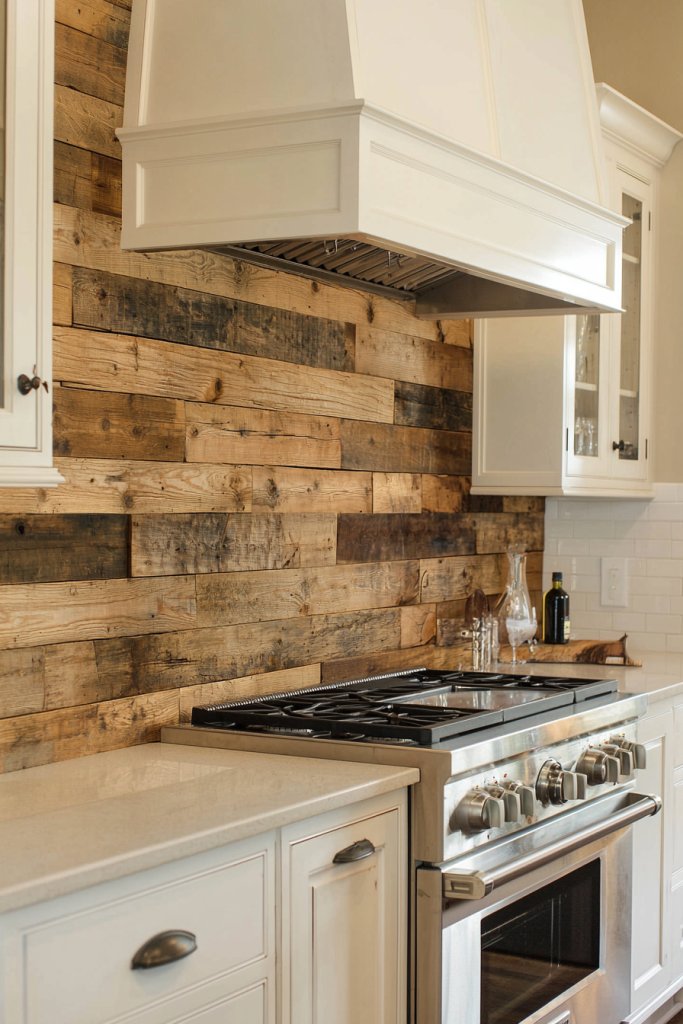
Reclaimed wood paneling instantly introduces warmth and rustic charm to a farmhouse kitchen, creating an inviting and cozy atmosphere that feels both authentic and eco-friendly. Its natural textures and weathered appearance add depth and character, making the space uniquely yours.
Picture wide planks of aged, weathered wood with visible grain, knots, and imperfections, arranged horizontally or vertically across the backsplash area. The wood’s warm, earthy tones—ranging from soft honey to deep chocolate—contrast beautifully with the crispness of white cabinetry or countertops. The tactile surface invites touch, while the subtle scent of aged wood adds a sensory layer to the space. This design exudes a handcrafted, vintage feel that makes your kitchen feel genuinely lived-in and loved.
To recreate this look, source reclaimed wood from sustainable suppliers or repurpose old barn or pallet wood, ensuring it’s properly cleaned and sealed for kitchen use. Cut the wood into wide strips, then attach them directly to the wall using construction adhesive or nails, ensuring level alignment. Finish with a matte or semi-gloss sealant to protect against moisture and stains. For a budget-friendly alternative, consider using faux reclaimed wood panels or wood-look vinyl wallpaper, which mimics the texture and appearance while being easier to install and maintain.
3. Patterned Ceramic Tiles for Visual Interest
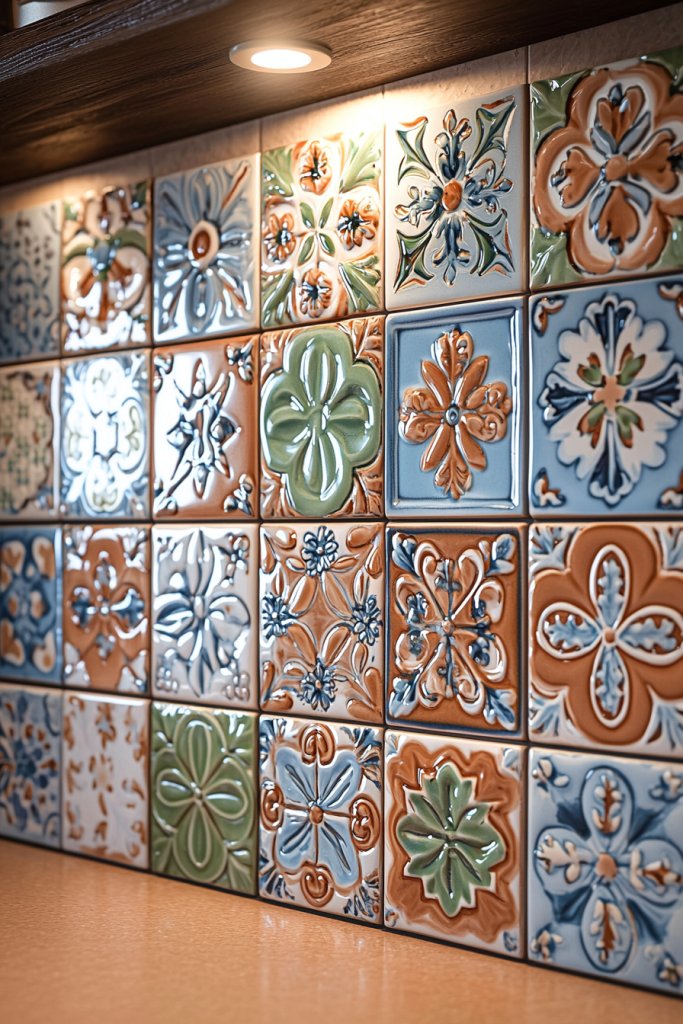
Patterned ceramic tiles are an excellent way to inject personality and visual intrigue into a farmhouse kitchen backsplash, turning a simple wall into a stunning focal point. They blend traditional charm with modern flair, making your space both stylish and memorable.
Visualize a mosaic of vibrant, intricately patterned tiles—perhaps with floral motifs, geometric shapes, or vintage-inspired designs—laid out in a harmonious arrangement. The colors might include soft blues, warm terracotta, or muted greens, creating a lively yet cozy palette. The textured surface of these tiles adds depth, while the glossy finish catches the light, enhancing their intricate details. This patterning creates a lively, handcrafted feel that elevates the farmhouse aesthetic with a touch of artistic flair.
To implement, choose ceramic tiles with vintage or bohemian patterns from home improvement stores or specialty tile shops. Measure your backsplash area to determine the number of tiles needed, and plan your layout before installation. Use a tile adhesive suited for ceramic tiles, and apply grout that complements or contrasts with the tile pattern—white for a crisp look or a darker shade for added depth. For easier DIY installation, consider peel-and-stick patterned tiles or pre-cut mosaic sheets. This approach offers an eye-catching, personalized touch that’s both affordable and straightforward to execute.
4. Shiplap Backsplash for Coastal Farmhouse Vibes
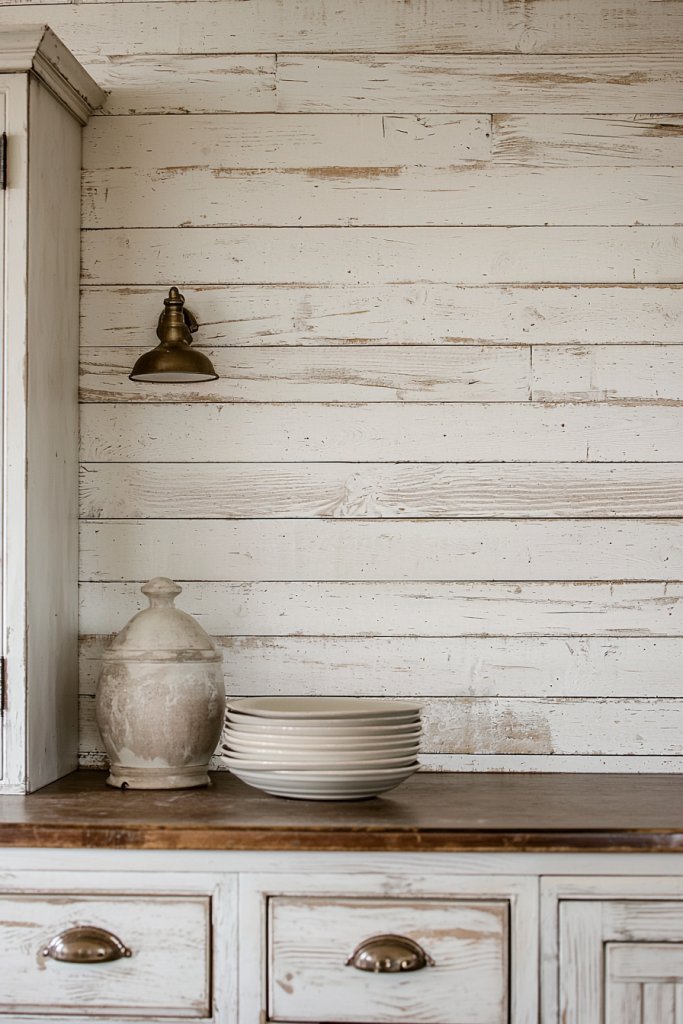
Shiplap walls are a hallmark of farmhouse design, and using shiplap as a backsplash creates a distinctive, textured backdrop filled with coastal charm. Its horizontal lines and weathered appearance evoke seaside cottages and rustic retreats, perfect for a relaxed farmhouse kitchen.
Imagine narrow wooden boards with a slight gap between each, painted in soft whites, creams, or light greys, emphasizing their natural grain and imperfections. The shiplap’s textured surface adds visual interest and depth, while the slight gaps allow for subtle shadowing, enhancing the rustic feel. When paired with vintage fixtures or distressed cabinetry, shiplap enhances the laid-back, coastal vibe that’s quintessentially farmhouse.
To create this look, purchase pre-painted or raw shiplap planks from a home improvement store. Measure your wall space carefully, then attach the planks horizontally using nails or adhesive, ensuring they stay level and evenly spaced. Finish with a protective sealant or paint if needed. For an easier or less permanent option, consider shiplap wallpaper or peel-and-stick panels that mimic the real wood’s texture. This approach provides a charming, durable backsplash that adds warmth and character, perfectly suited to a coastal-inspired farmhouse kitchen.
5. Beadboard Panels for Traditional Elegance
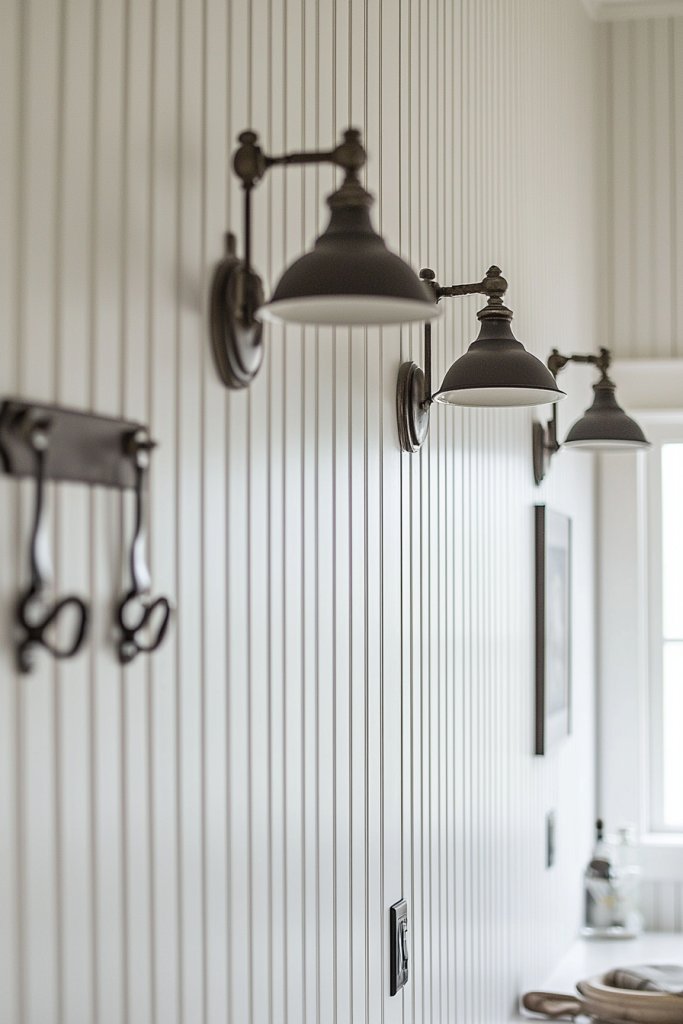
Beadboard panels bring a sense of traditional elegance and craftsmanship to a farmhouse kitchen backsplash, adding subtle vertical lines that create a refined yet cozy atmosphere. It’s a classic choice that balances decorative detail with practicality.
Envision narrow, tongue-and-groove panels painted in crisp white, with evenly spaced, rounded beads running vertically along the wall. The textured surface enhances the room’s charm, evoking vintage kitchens and cottage retreats. The panels’ smooth, painted finish reflects light softly, brightening the space and providing a clean, polished look. When paired with vintage hardware or farmhouse lighting, beadboard offers a timeless, elegant backdrop that complements both rustic and refined elements.
To install, purchase pre-cut beadboard panels designed for wall applications. Measure your backsplash area, then cut panels to size if necessary. Attach using panel adhesive or nails, making sure each panel aligns properly and the beads are evenly spaced. Finish with a coat of white semi-gloss or matte paint for durability and a polished look. For a quick update, peel-and-stick beadboard wallpaper offers a DIY-friendly alternative, allowing you to achieve the classic look without extensive carpentry. This method creates an elegant, traditional foundation that elevates your farmhouse kitchen’s overall aesthetic.
6. Hand-Painted Tile Murals for Artistic Flair

A hand-painted tile mural turns your backsplash into a captivating work of art, infusing your farmhouse kitchen with personality and charm. This approach allows you to showcase your creativity or incorporate meaningful designs, making your space uniquely yours. It’s an ideal way to blend traditional craftsmanship with rustic elegance.
Visualize a series of ceramic tiles, each featuring intricate, hand-painted patterns—floral motifs, vintage-inspired scenes, or simple geometric designs in soft, muted colors like sage green, blush pink, or creamy white. When arranged together, these tiles form a cohesive mural that becomes a stunning focal point behind your stove or sink. The textured brushstrokes and artisanal details add warmth and authenticity, echoing the handmade, vintage vibe of farmhouse decor. The overall effect is both charming and sophisticated, inviting admiration from guests.
To bring this idea to life, select blank or lightly glazed ceramic tiles suitable for painting. Use high-quality ceramic or oil-based paints for durability and color richness. Sketch your design lightly with pencil before painting, and apply multiple thin layers for vibrancy. Once finished, seal the artwork with a clear, heat-resistant sealer to protect it from moisture and cooking splatters. For an easier approach, look for pre-painted or customizable tiles from local artisans or online shops. This project is perfect for DIY enthusiasts willing to put in some artistic effort to create a truly personalized backsplash.
7. Brick Veneer for Textured Industrial Farmhouse Look
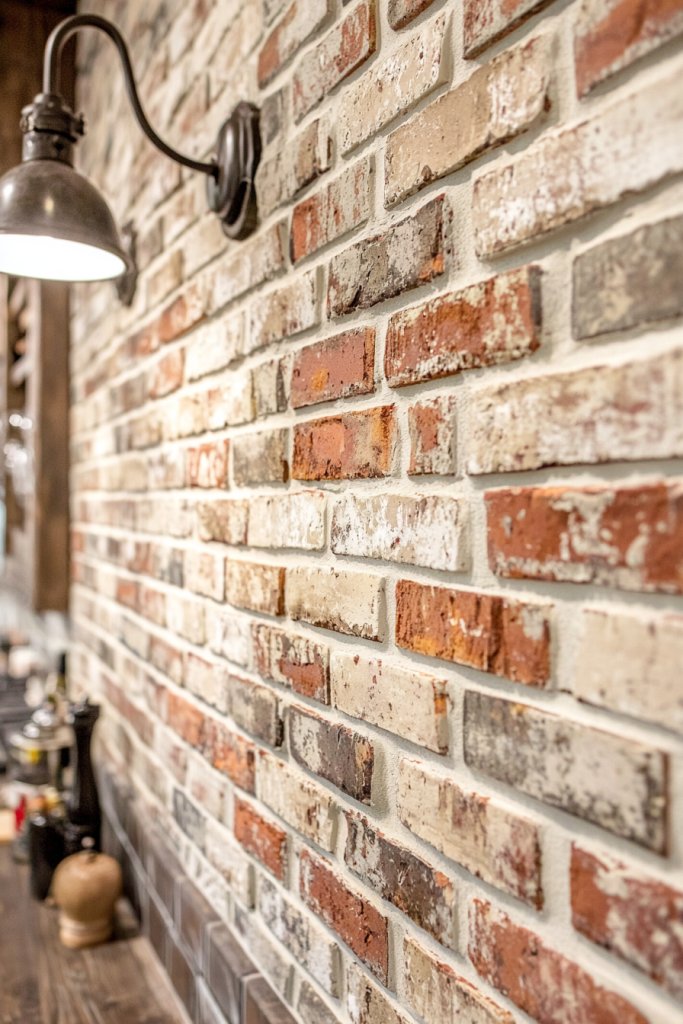
A brick veneer backsplash instantly introduces a rugged, textured element that embodies the industrial farmhouse aesthetic. It provides a striking visual contrast to smooth cabinetry and counters, giving your kitchen a warm, inviting yet edgy vibe. The layered brick surface adds depth and character, making it a memorable feature wall.
Picture a surface clad in small, rectangular bricks with a slightly weathered, uneven surface in shades of warm red, soft gray, or creamy beige. The rough texture invites touch, and the mortar lines create subtle shadows that enhance the rustic feel. The brick veneer, often lightweight and easy to install, pairs beautifully with reclaimed wood accents, vintage metal fixtures, and neutral-toned countertops. When lit well, it accentuates the natural imperfections and adds a cozy, lived-in atmosphere. The overall effect is a balanced mix of industrial edge and farmhouse warmth.
To install, measure your backsplash area carefully and choose a brick veneer style—either peel-and-stick panels or real thin brick tiles. Prepare the wall by cleaning and priming it, then apply adhesive or mortar as per product instructions. Press the bricks into place, ensuring tight joints. Finish with grout or caulk for a seamless look. For a quick DIY, peel-and-stick options are accessible for most skill levels, while traditional mortar installation offers a more authentic appearance. This textured backdrop elevates your kitchen’s style with minimal fuss and maximum impact.
8. Pegboard with Hooks for Practical Storage and Decor
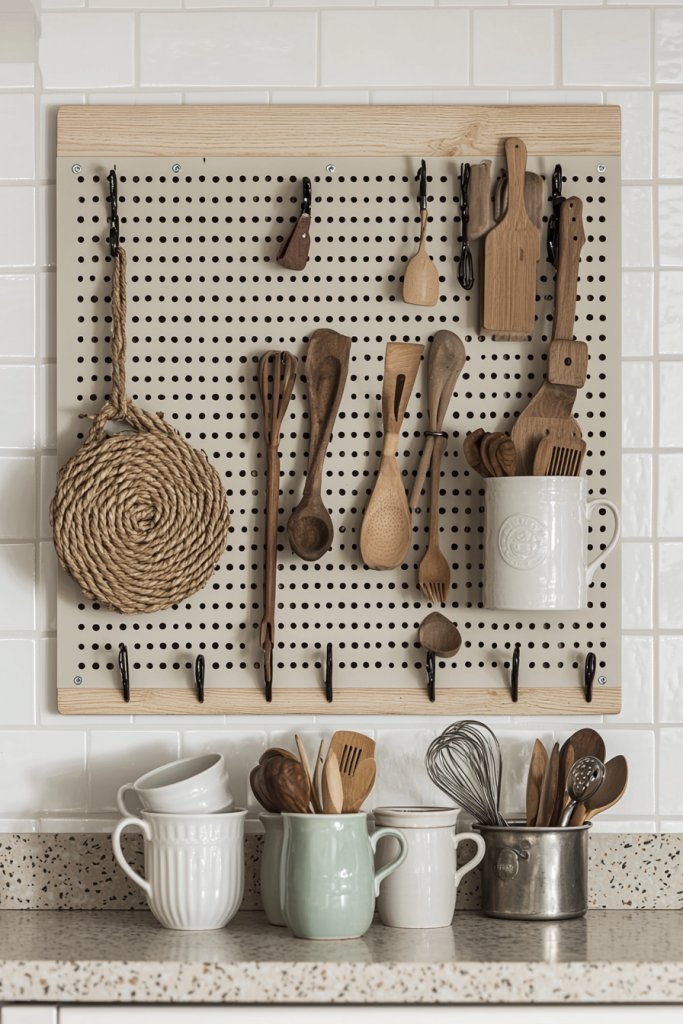
A pegboard with hooks offers a clever and customizable way to combine practical storage with charming farmhouse decor. It transforms an often-overlooked wall into a functional statement piece that keeps essentials within easy reach while adding rustic character to your kitchen.
Imagine a sturdy wooden pegboard painted in a soft, matte white or weathered gray, mounted neatly against a backsplash of white subway tiles or warm shiplap. The hooks hold a variety of items: vintage-inspired ceramic mugs, woven pot holders, rustic wooden spoons, or even decorative tin utensils. The open grid creates a sense of organized charm, with hooks and shelves arranged asymmetrically for a relaxed, inviting feel. The tactile contrast between smooth ceramics, rough wood, and metal accents enhances the cozy farmhouse vibe, while the scent of fresh herbs or baked goods nearby completes the sensory experience.
Getting started is simple and budget-friendly. You’ll need a wooden or metal pegboard, a pack of sturdy hooks, and some decorative elements like vintage ceramic cups or hanging baskets. Mount the pegboard securely on your wall using appropriate anchors, then arrange your hooks and accessories in a way that balances practicality with style. For a more authentic look, opt for reclaimed wood or paint the pegboard in a distressed finish. With just a few tools and some thoughtfully chosen items, you can create a charming, functional space that keeps your kitchen organized and visually appealing.
9. Salvaged Tin Tiles for Vintage Appeal
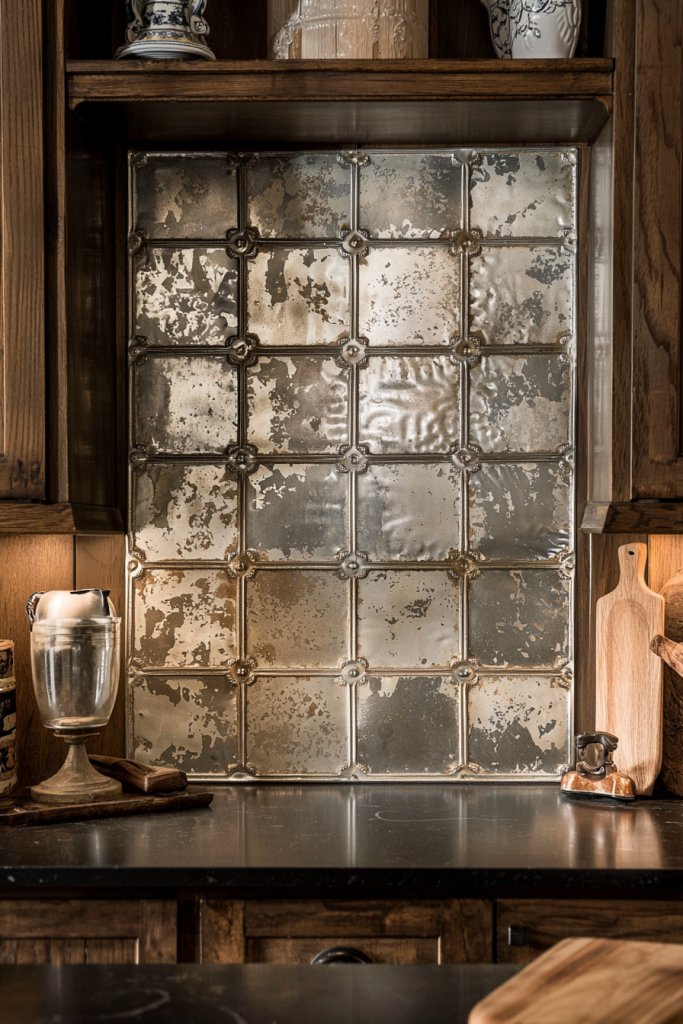
Transforming your farmhouse kitchen with salvaged tin tiles offers an authentic touch of vintage charm that instantly elevates the space. This material not only adds historical character but also brings a sense of warmth and nostalgia that’s perfect for creating a cozy, inviting atmosphere.
Imagine a backsplash composed of weathered, slightly hammered tin tiles, each with its own unique patina and subtle imperfections. The metallic surface shines softly in warm, muted tones of pewter and antique silver, reflecting light and adding a gentle shimmer to the room. The textured surface introduces a rustic yet refined aesthetic, while the aged finish evokes a storybook feel, complemented by the faint scent of old metal mingling with fresh herbs or baked goods nearby. The overall effect is a warm, textured focal point that complements natural wood cabinetry and vintage-inspired decor.
Recreating this look is simple and budget-friendly. Start by sourcing salvaged or reclaimed tin tiles from architectural salvage stores or online marketplaces. Clean and lightly polish them if needed, then secure them onto a prepared drywall or plywood backing with adhesive and nails for added stability. For an easier option, faux tin tiles made of lightweight metal or high-quality embossed plastic can achieve a similar vintage look. Finish by sealing the tiles with a clear protective coating to prevent tarnishing and ensure durability. With a few basic tools and a bit of patience, you can craft a stunning, vintage-inspired backsplash that becomes the statement piece of your farmhouse kitchen.
10. Distressed Masonry Wall for Weathered Charm
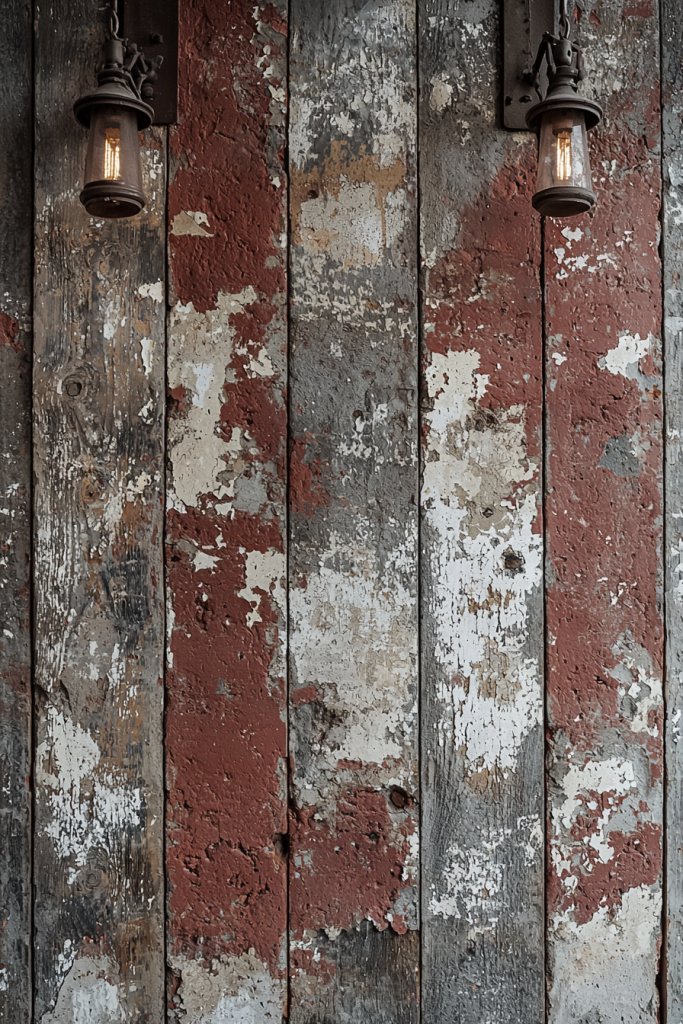
A distressed masonry wall brings a rugged, weathered charm to any farmhouse kitchen, creating a cozy, lived-in vibe that feels both timeless and inviting. It’s perfect for adding a touch of rustic authenticity, giving your space a sense of history and character that’s hard to replicate with modern finishes.
Imagine a wall of exposed brick with a deliberately worn, aged appearance—faded red and earthy tones with patches of gray and white where paint or mortar has chipped away. The textured surface is slightly rough to the touch, with uneven edges and a matte finish that absorbs light softly. This look pairs beautifully with warm wood accents and vintage metal fixtures, evoking a sense of enduring craftsmanship. The overall effect is warm, tactile, and subtly imperfect, emphasizing the charm of weathered materials.
To recreate this look, start by sourcing faux brick panels or real reclaimed bricks for authenticity. If using panels, choose those with a distressed or aged finish; for real bricks, consider a professional installation to ensure stability. Apply a thin layer of white or graywash paint to enhance the weathered appearance, or leave the bricks natural for a rawer feel. Finish with a clear matte sealant to protect the surface and maintain the aged look. This project can be done over a weekend, adding instant rustic charm to your kitchen.
11. Patterned Hexagon Tiles for Modern Farmhouse Twist
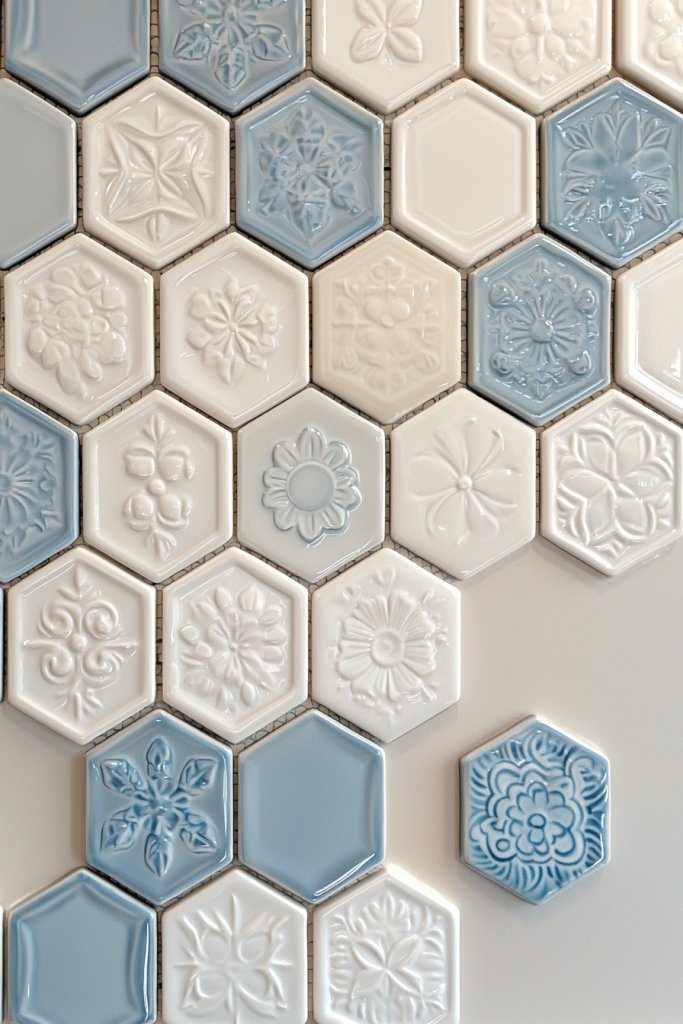
Patterned hexagon tiles introduce a fresh, modern twist to the classic farmhouse aesthetic, offering visual interest while maintaining a timeless appeal. Their geometric shape and intricate designs create a captivating focal point that elevates your backsplash from simple to stunning.
Visualize a wall lined with glossy ceramic hexagon tiles, each featuring a delicate pattern—perhaps a mix of soft blues, creamy whites, and subtle grays. The tiles interlock seamlessly, forming a honeycomb pattern that stretches across the wall. Some designs may incorporate subtle floral motifs or vintage-inspired motifs, adding layers of detail. The textured surface catches light differently throughout the day, creating a lively, dynamic backdrop. This design strikes a balance between contemporary and farmhouse styles, offering a versatile look that complements both rustic wood and sleek appliances.
To implement, choose patterned cement or ceramic hexagon tiles from your local tile shop or online. For a DIY-friendly option, opt for peel-and-stick tiles with preset patterns, which are easy to install and remove if needed. Prepare your wall by cleaning and leveling the surface, then apply a good-quality tile adhesive before placing each tile carefully to ensure even spacing. Grout with a neutral color, like soft gray or white, to emphasize the patterns. With a little patience, you’ll have a striking backsplash that’s both stylish and easy to maintain.
12. Open Shelving with Decorative Ceramics
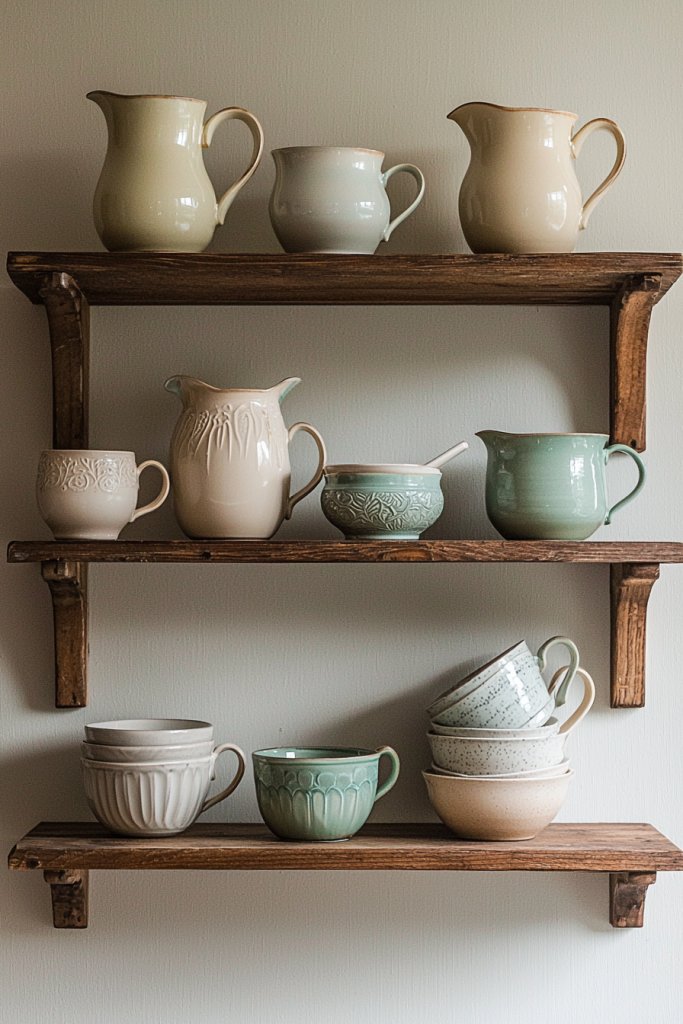
Open shelving topped with decorative ceramics instantly adds charm and personality to a farmhouse kitchen, blending functional storage with artistic display. It’s an easy way to showcase your favorite dishes and create a cozy, curated look.
Picture sturdy wooden shelves mounted securely against the wall, holding a collection of vintage-inspired ceramics—think hand-painted pitchers, rustic bowls, and charming mugs in soft, muted colors like cream, sage green, and dusty blue. The open design invites the eye to wander, making the space feel more open and inviting. Arranged thoughtfully, these ceramics serve as both practical items and decorative accents that add texture and visual interest. The combination of the warm wood shelves and the textured ceramics creates an inviting, homey atmosphere that’s perfect for everyday living or special gatherings.
To achieve this look, install floating wooden shelves using sturdy brackets or hidden supports. Use decorative ceramics—either vintage finds from thrift stores or new pieces with farmhouse-inspired designs. Arrange your collection with a mix of heights and shapes for visual balance. Finish with some small potted herbs or greenery for a touch of freshness, ensuring the space remains lively and personal. This setup is straightforward to assemble and provides endless opportunities for seasonal updates and personal touches.
13. Glass Mosaic Tiles for a Touch of Shine

Glass mosaic tiles add a subtle shimmer and sophisticated glow to a farmhouse kitchen backsplash, balancing rustic charm with a hint of modern elegance. Their reflective surfaces brighten the space and create a lively, airy atmosphere.
Imagine a wall covered in tiny, luminous glass tiles in shades of soft white, pale blue, or gentle taupe. The tiles are arranged in a grid or intricate pattern, with each piece catching light differently—sparkling under pendant lights or sunlight streaming through the window. The translucent surface adds depth and dimension, giving the illusion of more space. The smooth texture contrasts beautifully with rougher farmhouse elements like wood or brick, adding a touch of refinement without overpowering the rustic vibe. Overall, this backsplash provides a clean, polished look that still feels warm and inviting.
To install, choose pre-cut glass mosaic sheets for ease and consistency. Prepare your wall by cleaning and leveling it thoroughly. Use a high-quality mosaic adhesive to affix the sheets, pressing gently to eliminate air bubbles. Once set, grout with a light-colored, non-sanding grout to enhance the shimmering effect. Seal the surface with a grout sealer to protect against stains and moisture. This project is manageable for DIY enthusiasts, transforming your kitchen into a bright, stylish space with minimal fuss.
14. Neutral Pebble Tile for a Natural Element
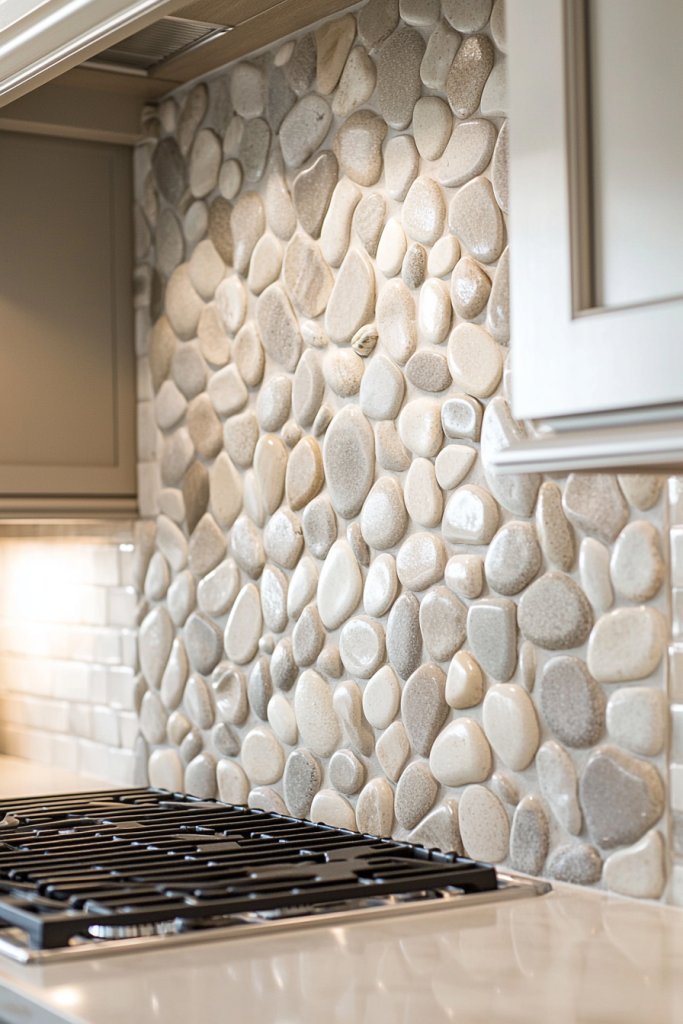
Bring a touch of nature into your farmhouse kitchen with neutral pebble tiles, creating a soothing and organic backdrop that feels both fresh and timeless. This natural element seamlessly blends rustic charm with modern simplicity, making it a versatile choice for a cozy yet stylish space.
Imagine a backsplash composed of smooth, rounded pebbles in soft shades of beige, gray, and ivory, arranged tightly together to form a continuous surface. The textured tiles evoke the gentle feel of riverbeds or beach shores, adding tactile interest to your kitchen. The subtle earth tones complement warm wood cabinets and white or cream walls, while the natural texture invites a calming, sensory experience—almost like a gentle breeze or the scent of fresh rain on stone. This design creates a peaceful, grounded atmosphere that enhances your farmhouse aesthetic with a touch of the outdoors.
To recreate this look, start with pre-made pebble tile sheets or individual pebbles set in a durable adhesive suitable for kitchens. If you prefer a DIY approach, select smooth, flat stones in neutral colors and carefully affix them onto a backing board or directly onto your wall, sealing them with a clear grout or sealant for easy cleaning. You can also opt for faux pebble tiles made from ceramic or resin for a budget-friendly and low-maintenance alternative. Once installed, pair your pebble backsplash with simple white or soft-toned countertops and warm-toned fixtures to complete the natural, farmhouse-inspired vibe.
15. Corrugated Metal Sheets for Industrial Edge
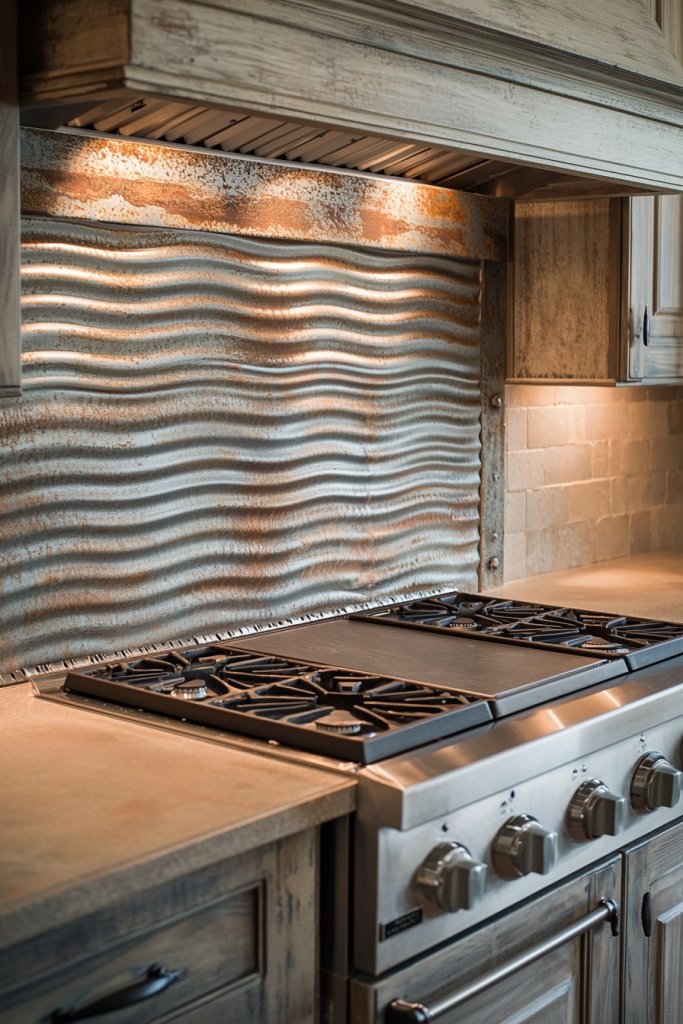
Adding corrugated metal sheets as a kitchen backsplash instantly introduces an edgy, industrial vibe that pairs beautifully with farmhouse charm. This material offers a bold, textured surface that reflects light subtly, creating a dynamic visual interest. Its rustic, weathered appearance can be achieved with either new or reclaimed metal, giving your space a rugged yet refined feel. The corrugation pattern adds depth and a tactile quality, making the backsplash a true focal point in your kitchen.
Visually, this backsplash features ridged, wave-like metal panels in shades of silver, gunmetal, or matte black, depending on your style preference. The metal’s surface might show intentional distressing—scratches, patina, or rust—to enhance its vintage appeal. The texture contrasts nicely with smooth wooden countertops or ceramic farmhouse sinks, while the metallic sheen catches the light, adding a subtle shimmer. The overall look feels sturdy and utilitarian, yet surprisingly warm when paired with cozy textiles and warm lighting.
To recreate this look, start by measuring your backsplash area and choosing either pre-cut corrugated metal panels or sheets that you can cut to size. Attach the panels securely using screws and washers, making sure to seal edges for safety. For a more budget-friendly option, consider faux metal adhesive wallpaper that mimics the corrugated texture. Finish with a clear sealant if you want extra durability against moisture and heat. Basic tools include a drill, screws, and a level—easy for DIY enthusiasts to manage with patience.
16. Layered Beadboard with Wainscoting Accents
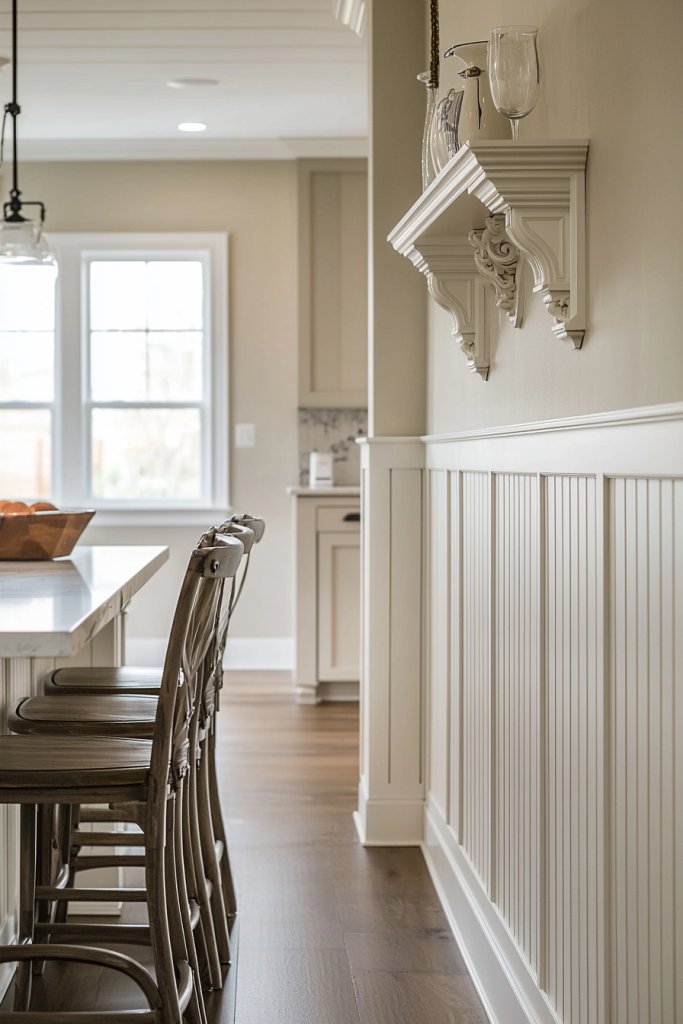
Layered beadboard with wainscoting accents creates a charming, traditional farmstead feel that adds both texture and height to your kitchen walls. This design combines horizontal or vertical beadboard panels at the lower portion of the wall with decorative wainscoting trims, giving a sophisticated, layered look. The soft, painted finish—often in whites, creams, or pastel shades—brightens the space while adding a cozy, cottage-inspired touch.
Imagine running beadboard panels in a warm, matte white or pale gray, with a decorative wainscoting border in a slightly darker hue or with intricate molding details. The beadboard’s narrow, vertical grooves invite the touch, while the wainscoting’s raised panels or carved trim provide a sense of craftsmanship. The layered effect creates visual interest and depth, making the kitchen feel inviting and timeless. The textures evoke a sense of handcrafted charm, perfect for a farmhouse aesthetic.
To install, start by measuring your wall to determine the height for the beadboard and wainscoting. Attach tongue-and-groove beadboard panels using nails or adhesive, then add wainscoting trim or molding along the top edge for a finished look. For an easier DIY, pre-assembled panel kits are available, and you can paint with semi-gloss or matte latex paint to match your color scheme. Seal all seams and edges with caulk for a clean, polished appearance that stands up to everyday kitchen use.
17. Vintage Tin Ceiling Tiles as Backsplash
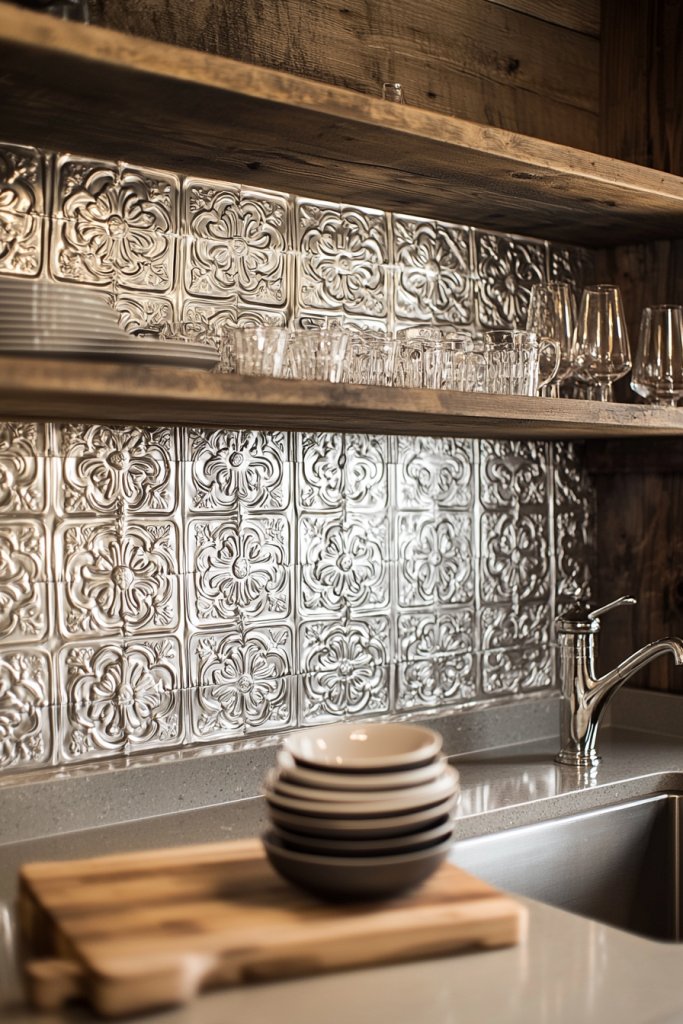
Using vintage tin ceiling tiles as a backsplash lends an authentic, nostalgic touch that instantly elevates any farmhouse kitchen. These intricately embossed metal tiles bring a sense of history and craftsmanship, transforming a simple wall into a statement piece. Their patterns—often floral, geometric, or Victorian-inspired—add decorative charm and texture, reflecting light in subtle, shimmering ways.
Visualize a wall covered in aged, slightly weathered tin tiles in soft silver, antique gold, or muted bronze hues. The embossed designs create a layered effect, with shadows and highlights emphasizing the ornate details. The metal’s slightly distressed finish enhances the vintage appeal, giving the space a well-loved, timeless feel. Paired with warm wood accents and vintage-inspired fixtures, this backsplash becomes a captivating focal point with rich visual depth.
To install, measure and cut the tin tiles to fit your space, using aviation snips or a metal cutter. Secure them with construction adhesive or nails, depending on your wall type, and seal the edges with silicone caulk to prevent moisture infiltration. For a more budget-conscious approach, faux tin tiles made from embossed PVC or vinyl are available, offering the same aesthetic with easier installation. A quick wipe with a damp cloth keeps the surface clean and shining—perfect for a farmhouse kitchen with vintage flair.
18. Handcrafted Clay Tiles for Unique Texture
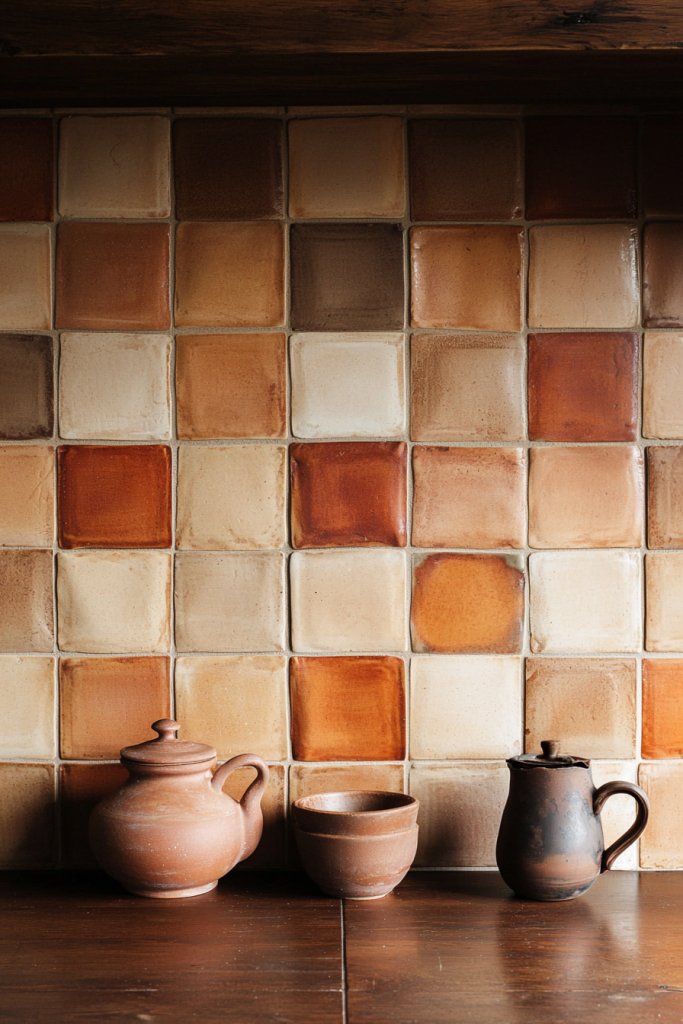
Handcrafted clay tiles introduce an artisanal, textured element that perfectly complements the rustic, cozy vibe of farmhouse kitchens. Each tile’s irregular shape, subtle color variations, and tactile surface tell a story of craftsmanship and individuality. The earthy tones—warm terracotta, soft creams, or muted browns—bring warmth and authenticity, making the space feel inviting and rooted in tradition.
Picture a backsplash composed of small, unevenly shaped clay tiles arranged in a simple grid or mosaic pattern. The surface might be matte or slightly glazed, with a natural, unpolished feel that invites touch. Variations in hue and texture contribute to a layered, organic look, while the warm colors balance the cooler tones of metal or stone accents. This handmade aesthetic adds depth and a sense of history to your kitchen, evoking a cozy, lived-in atmosphere.
To implement, source handmade clay tiles from local artisans or specialty tile suppliers, or consider making your own with clay and a kiln if you’re experienced. Arrange the tiles in your chosen pattern, then adhere them to a prepared wall with a flexible, grout-compatible adhesive. Use a natural or tinted grout to enhance the earthy appearance, and seal the tiles with a matte sealant to protect against moisture. This approach creates a truly one-of-a-kind backsplash that doubles as a piece of functional art.
19. Painted Shiplap with Decorative Borders
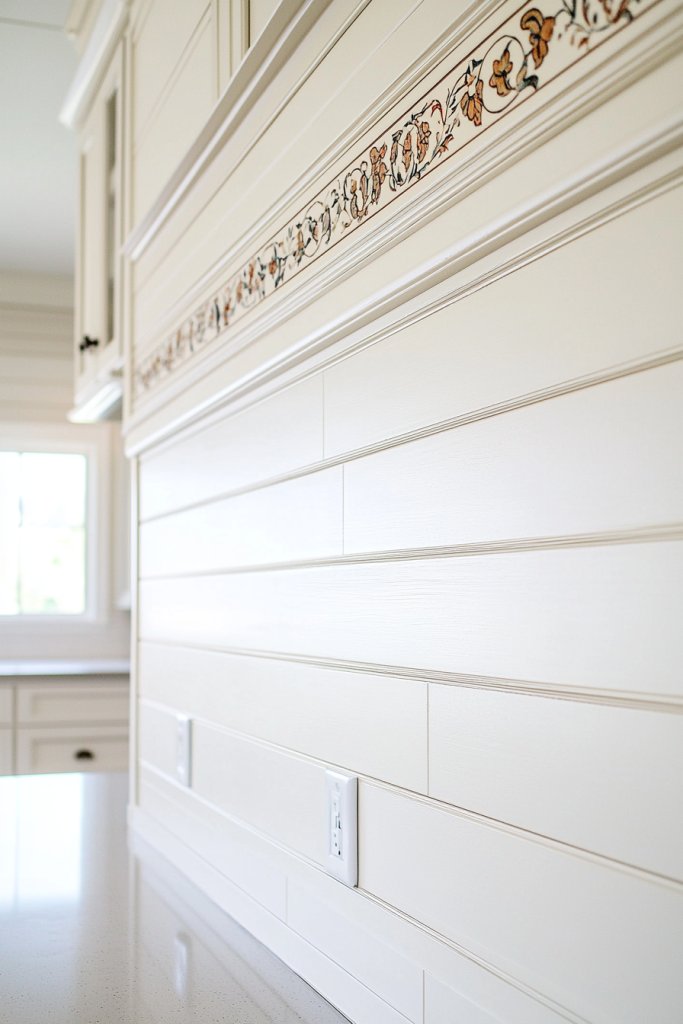
A painted shiplap backsplash with decorative borders combines rustic simplicity with artistic detail, creating a charming feature wall that’s easy to customize. The shiplap’s horizontal planks, painted in soft, neutral tones, evoke farmhouse warmth, while the decorative borders—perhaps with painted patterns or stenciled motifs—add a touch of refined craftsmanship. This design balances practicality and personal style effortlessly.
Picture crisp white shiplap planks extending across the wall, with a painted or stenciled border in a contrasting or complementary color—like navy, sage, or soft gray—running along the top or bottom edge. The border might feature simple stripes, floral motifs, or geometric patterns, adding visual interest without overwhelming the space. The textured wood surface combined with painted accents creates a layered, tactile experience that feels both cozy and curated.
To create this look, start by installing shiplap planks horizontally using nails or adhesive, ensuring they’re level. Then, paint the entire surface in your chosen base color. Once dry, use painter’s tape and stencils or freehand the decorative border with exterior-grade paint or chalk paint for durability. Finish with a clear matte or semi-gloss sealant for longevity. This project is beginner-friendly, customizable, and instantly transforms your kitchen into a warm, inviting farmhouse retreat.
20. Stone Veneer for a Robust, Natural Look

A stone veneer backsplash instantly brings a sense of strength and authenticity to a farmhouse kitchen, transforming the space into a cozy, earthy retreat. It’s an ideal choice for homeowners seeking a natural, “grounded” aesthetic that pairs well with rustic wood accents and vintage fixtures.
Imagine a wall covered in irregularly shaped, textured stones in warm earth tones—beige, taupe, and soft browns—that create a layered, tactile surface. The stones are slightly rough to the touch, with subtle variations in size and color that catch the light and add visual depth. The natural imperfections in the stone evoke a weathered, timeless charm, while the overall arrangement feels organic and inviting. The scent of mineral-rich stone and the gentle crackling sound of the textured surface enhance the sensory appeal, making the kitchen feel both rustic and sophisticated.
To recreate this look, start by choosing a real or faux stone veneer panel—many DIY-friendly options are available online or at home improvement stores. Measure your backsplash area carefully, then cut the panels to fit if needed. Attach the stone veneer using construction adhesive or mortar for a more authentic feel, following the manufacturer’s instructions. For a budget-friendly alternative, peel-and-stick faux stone panels are quick to install and require minimal tools. Seal the finished surface with a clear grout or sealant to protect against moisture and stains, and enjoy the robust, natural ambiance it adds to your farmhouse kitchen.
21. Patterned Cement Tiles for Artistic Detailing
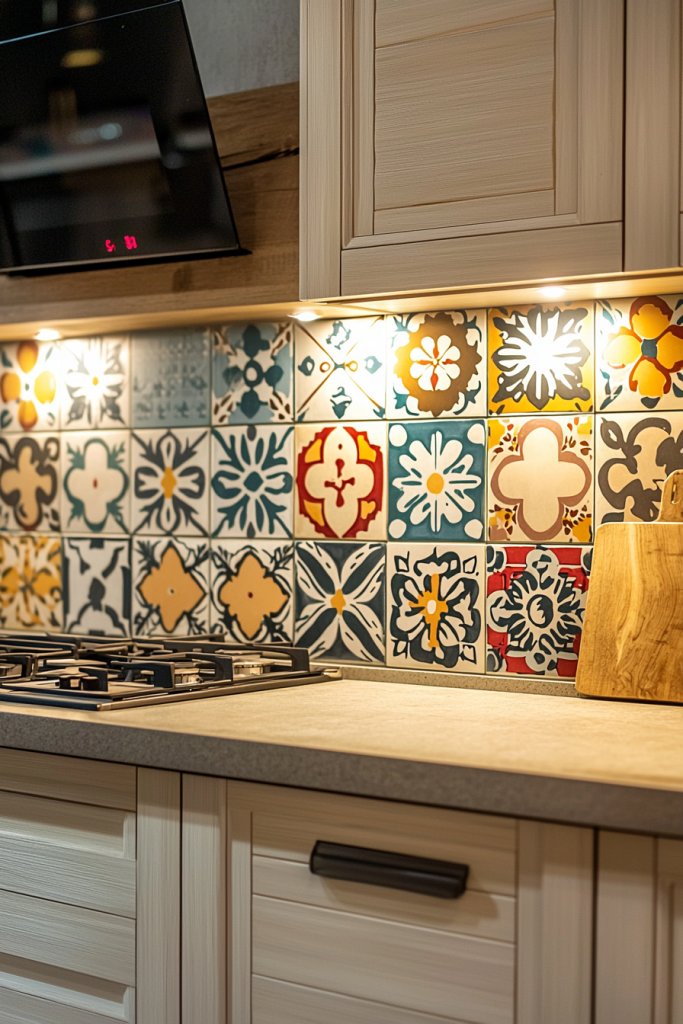
Patterned cement tiles serve as eye-catching accents that elevate a farmhouse kitchen backsplash with a touch of artisanal charm. Their intricate designs add personality and handcrafted character, making the space feel unique and inviting.
Picture a series of tiles with elaborate geometric or floral motifs in rich, muted colors like navy, terracotta, and cream. Each tile is slightly textured, with embossed patterns that catch the light differently depending on the angle. The overall layout can feature repeating patterns or a random patchwork for an eclectic look. These tiles create a rich visual tapestry that enhances the rustic yet stylish vibe of a farmhouse kitchen, with a subtle matte finish that absorbs light softly and complements vintage fixtures and distressed wood accents.
To implement this idea, select cement tiles from local suppliers or online stores specializing in vintage or handcrafted styles. Measure your backsplash area carefully to determine the number of tiles needed, allowing for cuts and pattern alignment. Prepare the surface by cleaning and leveling it, then apply a high-quality tile adhesive suitable for cement tiles. Lay the tiles carefully, ensuring consistent spacing and pattern alignment, and use spacers for a clean grout line. Finish with a durable sealant to protect against stains, and enjoy a stunning, artistic focal point that adds charm and individuality to your farmhouse kitchen.
22. Antique Mirror Panels for Light Reflection and Depth
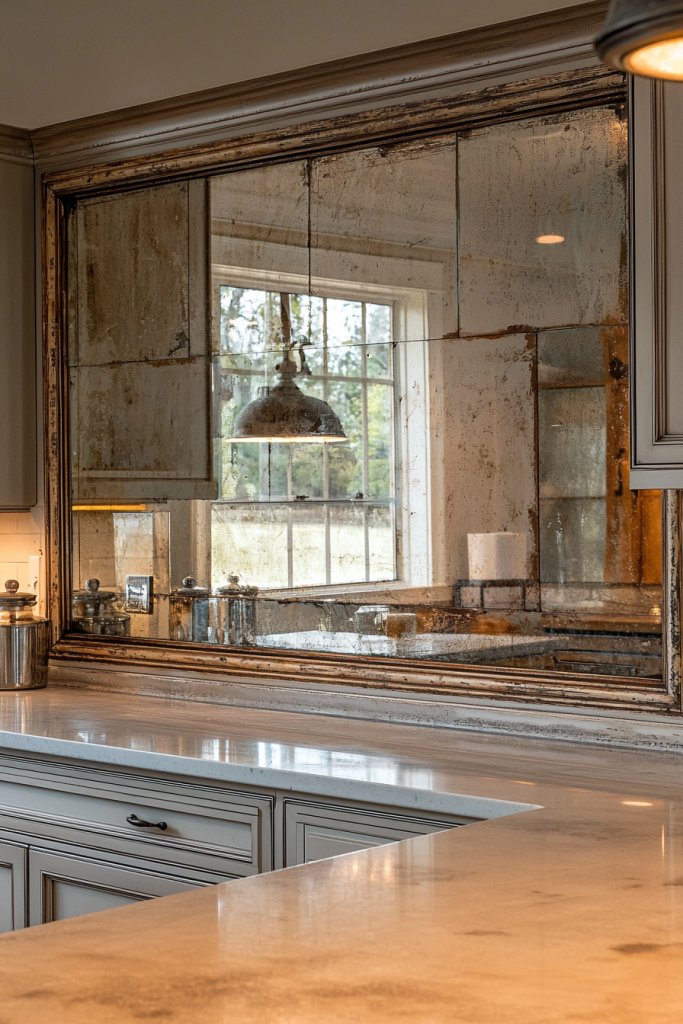
Antique mirror panels transform a farmhouse kitchen into a brighter, more spacious environment by reflecting light and adding a touch of vintage glamour. They subtly elevate the space with a hint of history and elegance.
Visualize large, slightly distressed mirror panels with a vintage copper or aged brass frame, arranged seamlessly across your backsplash. The mirrors’ antiqued finish features a soft patina, with subtle cracks and weathered textures that evoke a bygone era. When installed behind the stove or sink, they bounce natural and artificial light around the room, creating an illusion of depth and openness. The reflective surface also introduces a hint of glamour, balancing rustic elements with a sophisticated, historical charm. The gentle shimmer and the faint scent of aged metal enhance the sensory experience, making the kitchen feel both timeless and luminous.
For installation, choose antique or vintage-style mirror panels from salvage stores or online marketplaces. Measure your backsplash area carefully, then secure the panels with appropriate mirror adhesive or clips, following safety guidelines to prevent breakage. If needed, frame the panels with antique brass or distressed wood to complement the farmhouse aesthetic. Finish by sealing the edges with a specialized mirror sealant to prevent moisture damage. This simple yet impactful upgrade will reflect light beautifully and add a layer of visual interest to your rustic kitchen.
23. Farmhouse-inspired Decorative Tile Borders
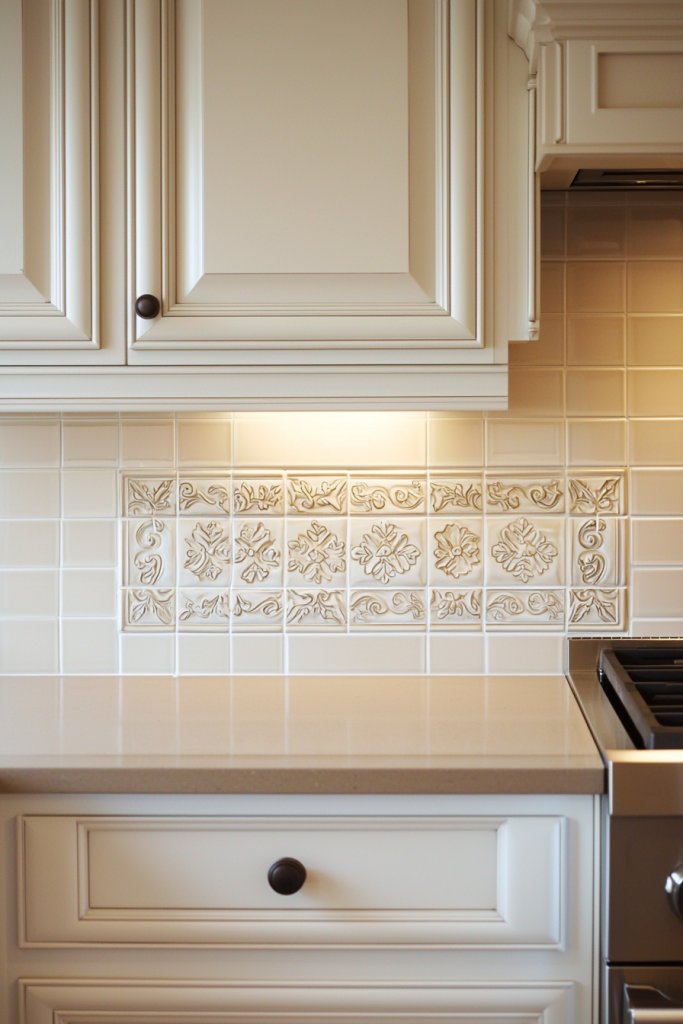
Decorative tile borders add a charming, finishing touch to farmhouse kitchen backsplashes, framing the space with subtle pattern and color that tie the design together. These borders enhance the rustic aesthetic with a handcrafted, timeless feel.
Picture a narrow strip of tiles with delicate, repetitive patterns—such as vine motifs, scalloped edges, or simple geometric lines—in tones of soft blue, warm terracotta, or creamy white. These borders are installed at eye level or along the top or bottom of the backsplash, creating a visual frame that draws the eye and adds architectural detail. The textured surface of the tiles provides tactile interest, while the subtle color palette complements other farmhouse elements like shiplap, wood cabinets, or vintage fixtures. This decorative touch balances functionality with artistry, elevating the overall style of your kitchen.
To install, select decorative border tiles that match your color scheme and pattern preference. Measure carefully and cut tiles as needed using a tile cutter or nippers. Apply a quality tile adhesive, then position the border tiles in the desired location, ensuring even spacing. Use spacers to keep lines straight and consistent. Once set, grout the borders with a color that complements your tiles—preferably a neutral tone for a seamless look—and seal the grout once dried. This simple addition creates a polished, cohesive look that beautifully frames your farmhouse kitchen.
24. Corrugated Wood with Metal Accents for Mixed Materials Style
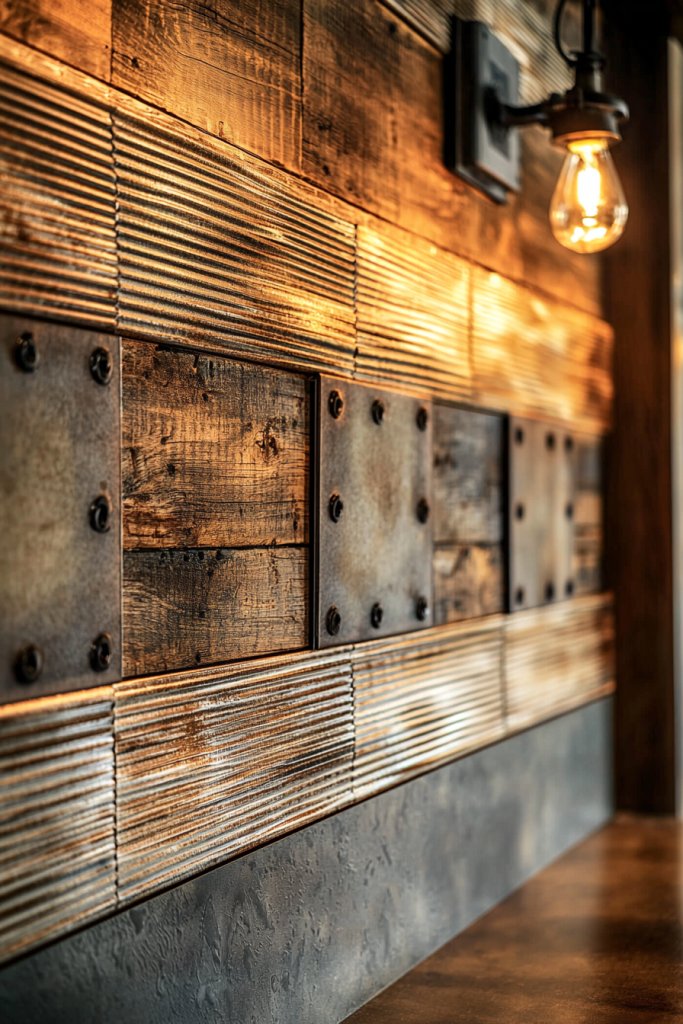
Combining corrugated wood with metal accents offers a bold, textured backsplash that embodies a modern farmhouse aesthetic with industrial edge. It’s a statement feature that adds depth and character through contrasting materials.
Visualize a wall lined with aged, weathered wood panels featuring a distinctive corrugated pattern, paired with metal accents such as brushed steel or blackened iron strips. The wood’s rustic texture—rough, grooved, and slightly distressed—contrasts beautifully with sleek metal details, creating a layered, tactile surface. The combination evokes a sense of craftsmanship and resilience, while the natural wood tones—warm browns and grayish hues—blend seamlessly with vintage or industrial decor elements. This textured mix not only looks striking but also enhances the sensory experience—think the roughness of wood under your fingertips and the cool, smooth feel of metal—adding depth to your farmhouse kitchen.
To bring this idea to life, source corrugated wood sheets from salvage yards or specialty suppliers, ensuring they’re treated for durability and moisture resistance. Attach the panels securely to the wall using heavy-duty screws or nails, and incorporate metal accents with brackets or strips to outline or accent specific areas. For an easier DIY approach, consider pre-finished panels and metal trim kits designed for wall applications. Make sure to seal the wood to protect against humidity, and enjoy a bold, textured backsplash that combines rustic warmth with industrial edge—perfect for a truly unique farmhouse kitchen statement.
Conclusion
With so many charming options—from classic white subway tiles and rustic reclaimed wood to vibrant patterned ceramics and vintage tin accents—there’s a farmhouse backsplash idea to suit every style and personality. These creative touches can transform your kitchen into a warm, inviting space that reflects your unique charm. Don’t be afraid to experiment and make these ideas your own—your perfect farmhouse kitchen is just a backsplash away. Start elevating your space today and enjoy the timeless beauty of a thoughtfully curated farmhouse kitchen.
Leave a Reply